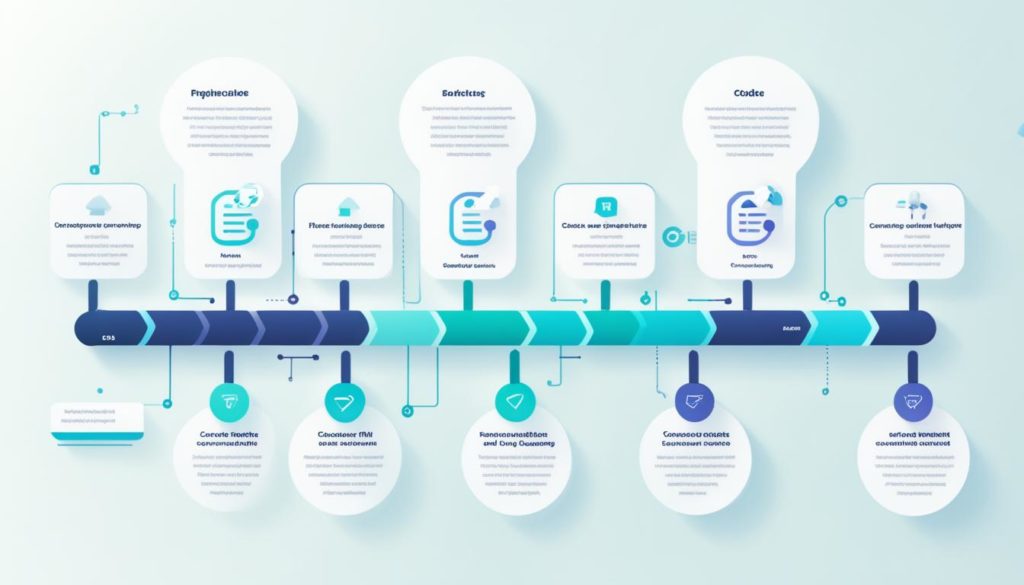
Did you know that over 50% of software development teams face delays because of technical debt? This fact shows how vital managing technical debt is in software development. As technical debt grows, it makes improving code quality harder, leading to more challenges and costs in the future.
In the fast-paced world of software development, technical debt happens when we pick quick fixes over lasting solutions. These quick fixes might speed up projects now, but they can hurt the software’s long-term upkeep and function.
We focus on finding a balance between fast releases and keeping code quality high. By tackling technical debt early, we help create stronger and more flexible software solutions.
Key Takeaways
- Over 50% of development teams experience delays due to technical debt.
- Effective technical debt management is crucial for a streamlined software development process.
- Balancing quick deliverables with future maintainability is essential.
- Addressing technical debt early ensures better code quality improvement.
- Proactive strategies lead to more robust and scalable software solutions.
Understanding Technical Debt
Technical debt is a common issue in software engineering. Teams often choose quick releases over long-term code health. This choice leads to technical debt, needing future refactoring to keep systems stable.
Definition of Technical Debt
Technical debt means paying the cost of rushing software updates. It’s the extra work needed to fix poor coding choices made under pressure or with limited resources. For more details, check out this in-depth explanation.
Causes of Technical Debt
- Fast project timelines pushing for quick deliveries.
- Poor planning or team communication issues.
- Limited resources for thorough code review and testing.
- Insufficient or outdated skills in the team.
Impacts of Technical Debt on Software Development
Ignoring technical debt brings big technical challenges. It leads to slower feature releases, less productivity, and higher maintenance costs. Agile teams accept it as part of their work. But, waterfall teams might struggle more due to communication issues. It’s vital to understand its effects on the IT infrastructure for better management and team morale.
| Impact | Description |
|---|---|
| Slower Rollouts | Technical debt delays new feature delivery due to constant refactoring needs. |
| Decreased Productivity | Teams spend more time on fixing code issues than innovating. |
| Escalating Costs | Fixing issues from technical debt costs a lot more over time. |
Identifying Technical Debt
Identifying technical debt is key for a project’s success. With modern tools and practices, we can spot and manage it well. This keeps our software projects healthy over time.
Code Analysis Tools
Tools like Sonarqube, Code Climate, and PMD are vital for finding technical debt. They help us see code smells, duplication, and other debt signs. By using these tools often, we can fix problems early. This helps with steady software upkeep and keeps project timelines smoother.
Code Review Practices
Strong code review practices are crucial for quality code. Regular reviews mean everyone owns the code and spots debt early. This sharing of knowledge and accountability leads to better maintenance.
Reviews also help keep coding standards high. This stops new debt from building up.
Tracking Technical Debt in Project Management Tools
Adding technical debt tracking to tools like JIRA or Trello helps us keep an eye on it. This way, debt isn’t forgotten and is part of our project plan. Tracking debt helps us decide on refactoring and other maintenance steps.
Using these tools gives us a clear view of our project’s health. It leads to smoother and more predictable software development.
Technical Debt in Software Development
In software development, technical debt often comes from the need to make quick decisions. These decisions are made because of limited time, resources, or team skills. It’s not about taking shortcuts or being lazy.
Fixing technical debt means understanding software architecture and following strict code quality rules. These are key to managing technical debt well. They help avoid it from growing into a big problem that stops innovation and progress.
Working on reducing technical debt means keeping code quality high. This means always checking and using strong software architecture to avoid problems later. Having a plan to pay off technical debt helps keep it in check. This makes it easier to keep developing software in a healthy way.
In the end, seeing technical debt as a strategic choice helps us find good solutions. By keeping code quality high and solving architectural issues, we balance short-term needs with long-term stability.
Preventing Technical Debt
Keeping our software projects healthy and efficient is key. We can do this by using smart strategies to avoid technical debt. Let’s look at some effective ways to achieve this goal.
Implementing Coding Standards
Using coding standards is crucial for quality software. These standards make sure all developers code the same way. This makes the code easier to read and work with, and helps the team work better together.
Continuous Integration and Testing

Regular Refactoring
Refactoring means cleaning up code to make it better. It’s a key part of good software engineering. By removing old code and making things more logical, we keep the software flexible and able to grow.
Effective Documentation
Good documentation standards are important for clear records of how the software was made. They help new people join the team, make fixing problems easier, and encourage learning. This keeps the code quality up and helps avoid technical debt.
| Practice | Benefit |
|---|---|
| Implementing Coding Standards | Enhances code readability and maintainability |
| Continuous Integration and Testing | Ensures early detection of issues |
| Regular Refactoring | Improves code efficiency and scalability |
| Effective Documentation | Supports onboarding and troubleshooting |
Prioritizing Technical Debt Reduction
Managing technical debt well is key to keeping our software development efficient. Without a plan to pay off technical debt, companies can see more bugs, security issues, and higher upkeep costs. By using smart strategies, we can work on new features and keep the code healthy at the same time.
First, we focus on paying off technical debt on purpose. We look at things like defect rates and code quality to set priorities. Using automated tools helps make development smoother. This lets developers work on new stuff while fixing old problems.
Having a strong maintenance plan is vital for handling technical debt. We do regular checks and make improvements, and keep testing and integrating code. This keeps the code solid and boosts development speed, cutting down on time spent on simple fixes.
Acting on technical debt early stops unhappy customers and keeps developers happy. For more tips on managing technical debt, check out this article. It has great advice and strategies.
By following these ideas, we make a lasting place for innovation and reduce risks. Finding the right balance between now and later is key for ongoing success and growth in our projects.
Managing Technical Debt in Agile Environments
Managing technical debt in Agile needs a smart plan for project health. This includes good sprint planning, a balanced project roadmap, and teamwork. It makes our work better.
Incorporating Technical Debt in Sprint Planning
We make technical debt a top priority in sprint planning. By setting tasks to reduce debt in each sprint, the team works on it step by step. This keeps the project on track while we fix these issues.
Creating a Balanced Roadmap
A good project roadmap balances fixing technical debt with adding new features. This stops debt from growing too much and lets us move forward on new things. The roadmap should show when we focus on debt, making sure these tasks don’t get missed.
| Roadmap Element | Focus | Outcome |
|---|---|---|
| Initial Sprints | Feature Development | High User Engagement |
| Mid-Project Sprints | Technical Debt Management | Improved Code Quality |
| Final Sprints | Hybrid Approach | Balanced Product Delivery |
Communication and Collaboration Strategies
Talking openly and working well together is key to handling technical debt in Agile. It’s important that the team talks about debt and its effects. This way, everyone knows what’s needed to fix it and move the project forward.
To manage technical debt well in Agile, we need a full plan. This includes planning sprints, keeping a balanced roadmap, and teamwork. Doing this helps us deal with debt and keep our projects strong and successful.
Tools and Techniques for Reducing Technical Debt
Managing technical debt needs the right tools and methods. We use software development tools and debt reduction techniques. These strategies focus on optimizing our codebase and making our work more efficient.
- Code Refactoring: This means changing the code without altering how it works. It makes the code easier to read and less complex, which is good for the codebase.
- Adoption of New Software Versions: Using newer frameworks like .NET 6 brings in new features and better security. This helps us reduce debt over time.
- Enforcing Code Reviews: Regular checks by other developers make sure we follow the rules and spot problems early. This helps avoid more debt later.
- Automated Testing: Automated tests check if our code works right and is solid. This keeps our codebase stable and of high quality.
- Strategic Refactoring: We focus on improving the parts of our code with the most debt. This makes our code better and easier to maintain.
Understanding the software development process is also key. Using advanced tools and strong debt reduction methods helps us keep our code in top shape. Let’s see how these tools and techniques compare:
| Tool/Technique | Primary Function | Benefits |
|---|---|---|
| Code Refactoring | Restructure code for simplicity | Improved readability and reduced complexity |
| New Software Versions | Adopt up-to-date frameworks | Enhanced features and security |
| Code Reviews | Peer evaluation of code | Ensures coding standards compliance |
| Automated Testing | Automated validation of code functionality | Ensures integrity and quality |
| Strategic Refactoring | Targeted improvement of code areas | Enhanced performance and maintainability |
Conclusion
Managing technical debt is key to keeping software projects healthy and innovative. Teams should always be on the lookout for and tackle technical debt. This means using the right tools, following best coding practices, and using Agile methods for progress.
It’s important to know how technical debt affects software development. It impacts code stability, security, and how easy it is for users to use the software. Teams should have a plan to deal with these issues. Tools like code analysis and tracking technical debt in project systems help a lot.
Teams should focus on preventing and reducing technical debt. This can be done by using continuous integration, refactoring, and good documentation. A balanced and team effort is crucial in software development. For more on managing technical debt, check out this guide from SonarSource.
FAQ
What is technical debt?
Technical debt is like a metaphorical loan. It’s the extra work we take on when we pick quick, not always best, solutions in making software. It shows the trade-off between fast releases and the cost of keeping things running well later.
What are the common causes of technical debt?
Technical debt comes from many things like tight deadlines, not enough resources, skill gaps, poor planning, and bad communication. These issues lead to quick fixes that might need more work later.
How does technical debt impact software development?
If we don’t fix technical debt, it slows down adding new features, lowers productivity, raises costs, and increases bugs and security risks. It makes making quality software harder and upkeep more difficult.
How can we identify technical debt within our codebase?
To find technical debt, use tools like Sonarqube, Code Climate, and PMD to spot code smells and duplicates. Doing code reviews and tracking it in tools like JIRA or Trello helps manage it well.
What role do coding standards play in preventing technical debt?
Coding standards are key to keeping code easy to maintain. Following best practices, continuous integration, automated testing, regular refactoring, and detailed documentation helps avoid technical debt.
How should we prioritize technical debt reduction?
To reduce technical debt, plan and prioritize carefully. Regularly tackling it helps avoid business problems, boosts customer happiness, and keeps developers productive. It’s important to balance adding new features with keeping the code healthy.
How do Agile methodologies help manage technical debt?
Agile helps manage technical debt by adding it to sprint plans, balancing new features with debt reduction, and encouraging open talks with everyone involved. This way, technical debt gets looked at regularly and doesn’t slow down projects.
What tools and techniques are effective for reducing technical debt?
Good ways to cut technical debt include refactoring code, using newer software (like .NET 6), following coding standards, doing code reviews, automating tests, and strategic refactoring. These steps strengthen the software’s structure and security.
Future App Studios is an award-winning software development & outsourcing company. Our team of experts is ready to craft the solution your company needs.









